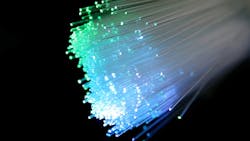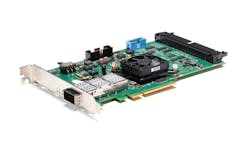Extending the Benefits of CoaXPress with CoaXPress over Fiber
CoaXPress is an asymmetric, point-to-point serial communication standard used for the high throughput transmission of data between a camera and a host PC. First demonstrated at VISION 2008 in Stuttgart, Germany, CoaXPress (CXP) became an official standard in 2011 after several years of development. CoaXPress is hosted by the Japan Industrial Imaging Association (JIAA) (Tokyo, Japan; www.jiia.org) in an alliance between itself, the European Machine Vision Association (Barcelona, Spain; www.emva.org), and Association for Advancing Automation (A3) (Ann Arbor, MI, USA; www.automate.org).
CoaXPress’s physical medium between cameras, PCs, and frame grabbers is 75-Ω coaxial cable. However, as this article explains, that may be changing soon, with the expansion of transmission bandwidth moving towards 100, 200, and even 400 Gigabits per second (Gbps) via fiber optics.
An Evolving Standard
The original version of the standard was CXP-6. It enabled a single coaxial cable to transfer data at rates up to 6.25 Gbps, with an effective data rate of 5.0 Gbps because of 8b10b encoding overhead. When aggregated, typically over two or four links, it was faster than any other interface at the time including GigE Vision, Camera Link, and USB. Besides speed, CXP-6 ushered in a host of new benefits including more precise triggering, longer cable lengths, and single cable integration for data, control, power [power over CXP (PoCXP)], and communications. CXP-6 soon proved itself ideal for high-speed semiconductor inspection, detecting defects in OLEDs, 3D Automated Optical Inspection, Intelligent Traffic Systems, and biomedical research, among other demanding applications.
CoaXPress 2.1, the standard’s most current version, was released in February 2021. This version added two new speeds, 10 Gbps (CXP-10) and 12.5 Gbps (CXP-12), that effectively doubled the bandwidth of the original version. Because it is scalable from one (single) to two (dual) or four (quad) cables, the CXP 2.1 protocol can reliably achieve bandwidths up to 50 Gbps from one quad link camera when using a four-lane link configuration. The downside in this configuration is that maximum cable length is only 35 m, which limits 50 Gbps transmission to shorter distances.
CoaXPress 2.1 also doubled the uplink speed and added support for the GenICam generic programming interface and the GenDC generic data container to help simplify integration work for component vendors and users. A new connector type, the Micro-BNC (HD-BNC), replaced the push-pull DIN connector specified in the CXP-6 standard.
Introducing CoaXPress over Fiber
Along with other upgrades, CoaXPress 2.1 features an add-on designed to let the CoaXPress protocol run unmodified over a standard Ethernet connection, including fiber optics. This add-on is dubbed “CoaXPress over Fiber” (CXPoF). Basically, it takes virtually all the advantages of CoaXPress discussed above and combines them with the performance benefits of fiber optic cabling.
The key to CXPoF is that it uses Ethernet Layer 1; that is, the layer where data is physically moved across a network interface. Layer 1 technologies are at the very lowest level of a network. As such, it is responsible for the encoding and signaling functions that transform data from bits that reside within a device into signals that can be transmitted over the network.
Importantly, Layer 1 defines hardware specifications, such as cables, connectors, and network interface cards. Therefore, whenever an upgrade comes to a Layer 1 component, it will directly benefit CXPoF, whether that upgrade translates into more bandwidth or lower prices. Compared with machine vision, Ethernet-based computer networking has huge sales volumes, which has driven its component prices down. These more economical components, such as cables and connectors, can lower the overall price of a CXPoF vision system.
CXPoF Speed
CXPoF’s net bandwidth is the same as CXP-12—approximately 40 Gbps. However, instead of requiring four CXP-12 links and four coaxial connections to achieve this, CXPoF transmits 40 Gbps on a single QSFP+ (Quad Small Form Factor Pluggable) transceiver module and a single fiber optic cable.
As speeds increase further from 12.5 Gbps to the JIIA’s expected 25 Gbps via QSFP28 and 50 Gbps via QSFP56 per lane, it’s possible that CXPoF will become the dominant standard.
Benefits of Fiber Cables
Fiber optics transmit data as pulses of light through strands of fiber made of glass or plastic. When bundled with hundreds of other strands, the resulting fiber optic cable will transmit more data at faster speeds and over much longer distances than high-grade copper cables. Also, fiber optics are electrically isolated. Accordingly, it does not radiate, and it is not susceptible to electromagnetic interference (EMI) that can slow transmission speeds or create crosstalk. Fiber optic cable isolation eliminates problems associated with grounding as well.
From the installer’s perspective, fiber optic cables offer several advantages. For one, fiber optic cables do not represent a fire hazard as heat is not dissipated. Second, the cables can withstand significant pull forces without suffering breakage over long runs compared to copper cabling. Third, fiber optic cables are not damaged by inclement weather, moisture, or temperature extremes to the same extent as coaxial or Ethernet cables. Finally, being lighter and smaller in diameter than other cable types, fiber optic cables can be easily threaded on machines, robots, aircraft, and ground vehicles.
There are two types of fiber optic cables: Single Mode Fiber (SMF) and Multi-Mode Fiber (MMF). The difference is in the size of the core. MMF has a much wider core, allowing multiple modes or “rays” of light to propagate. SMF has a very narrow core, allowing only a single mode of light to propagate. In general, SMF cable is for extremely long-distance signal transmission, while applications requiring a larger volume of data to be sent over a shorter run tend to use MMF cabling. CXPoF is expected to achieve distances up to 80 km (about 49.71 mi) in single-mode and 300 m (about 984.25 ft) in multi-mode without the use of error-prone extenders. On the downside, CXPoF cannot send power over a fiber optic cable to a camera. PoCXP notwithstanding, CXPoF keeps and builds on all the benefits of the CXP protocol.
Upgrading CXP to CXPoF
As an extension of the CoaXPress protocol, CXPoF provides the generic GenICam programming interface for hardware and software, plus is independent of any operating system, making it simple to upgrade from coaxial to fiber optics. Upgrading will require CXPoF-compliant cameras and frame grabbers, as well as fiber optic cabling, transceivers, and connectors. Vendors are beginning to recognize the market potential of CXPoF. Consequently, hardware choices are limited now but are projected to grow exponentially as has been the case with previous CXP upgrades.
A CXPoF frame grabber will have a fiber transceiver slot supporting QFSP+ compatible fiber cable assemblies. The assembly will provide up to four connections to support one quad link camera, two dual link cameras, or four single link cameras. CXPoF frame grabbers use the same half-Size x8 PCI Express Gen 3.0 platform as CXP frame grabbers, making it simple to swap out in the host PC. The optical transceiver module consists of a receiving end and a transmitting end. The receiving part realizes a photoelectric conversion, and the transmitting part realizes an electrooptical conversion.
A single fiber optic cable can achieve speeds of 40 Gbps. This means that fewer cables are required to transmit data, reducing the complexity of the cable run, lowering system costs, and minimizing potential failure points, especially if fiber extenders were previously required.
What are Use Cases for CXPoF?
CXPoF opens a new realm of opportunities. It is likely that the first applications to take advantage of CXPoF will be in situations requiring exceptionally long cabling such as intelligent transportation systems (ITS) or ballistics testing, or when electrical isolation is required between the camera and the PC as is the case in noisy industrial sites and sensitive medical environments.
In addition, as mentioned, economics will play a role in the pace at which CXPoF is adopted. CXPoF has cost benefits over traditional coax because of its ability to use Ethernet networking components, especially as this applies to cable costs. For example, a 30M quad CXP-12 coaxial cable costs over $600, while a 30M QSFP+ AOC (Active optical cable) costs about $125. Combined with its other advantages, this cost effectiveness might be enough to convince system integrators to migrate to CXPoF.
About the Author

Donal Waide
Donal Waide is the global director of business development for frame grabbers, part of the Industrial Cloud and Video Group, Advantech (Taipei, Taiwan). He became a member of the Advantech team in October 2023 after Advantech acquired Waide's previous employer, BitFlow (Woburn, MA, USA), where Waide was the Director of Sales, a role he held for 13 years. Educated at the University of Limerick, Ireland, he now resides just outside Boston, MA, USA, where he has lived for over 30 years. Waide has been involved in the machine vision world since 1997.

